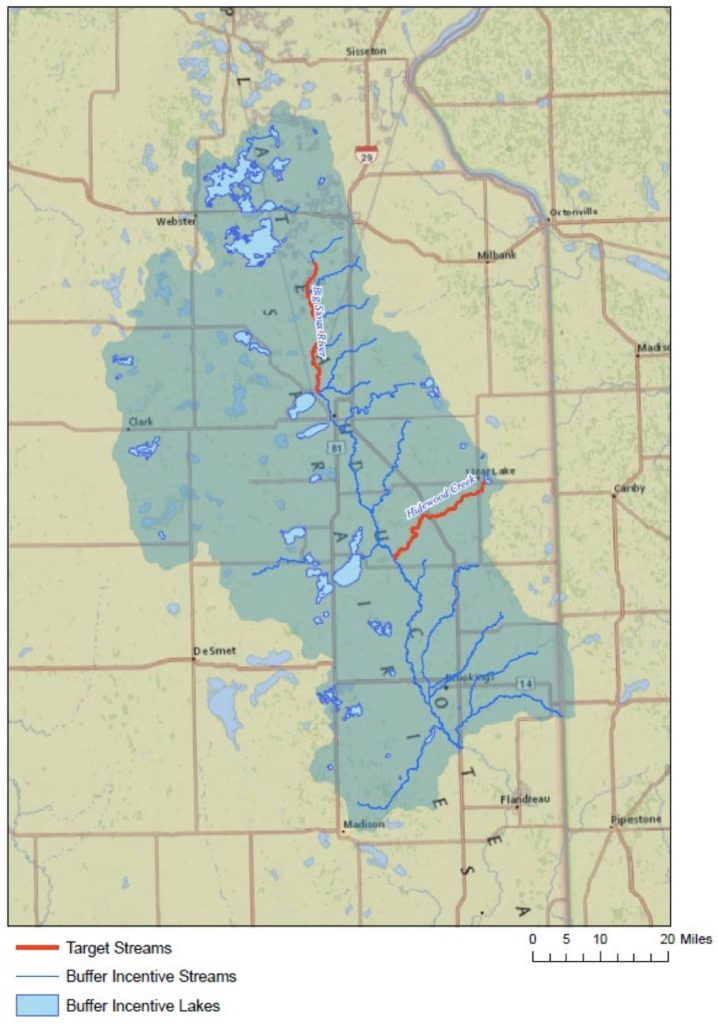The Department of Agriculture (and Natural Resources) updated Joint Appropriations yesterday on its effort to recruit landowners to convert 3,000 more acres of streamside cropland and pasture to grass over the next five years. These riparian buffer strips can filter cow poop, chemical fertilizer, and other pollution and improve water quality in our streams and lakes.
Recognizing that landowners have only enrolled several hundred acres in the riparian buffer program since its enactment in 2017, the 2021 Legislature came up with House Bill 1042, which lowered the property tax assessment on enrolled grassy strips and reduced the paperwork necessary to get the riparian buffer tax break. The state rents the 50- to 120-foot-wide grassy strips for ten years at rates equal to 50% of county Conservation Reserve Program rates along non-targeted streams and 100% of CRP rates along targeted streams. The program will also share the cost of fencing the buffer strips and providing landowners with alternative water sources (i.e., alternatives to letting their livestock tromp down to the creek and poop in the water) at Natural Resources Conservation Service rates up to $5,000 per contract.
Most of the targeted streams are in the intensely cultivated and CAFO’d Big Sioux River watershed—two in the northern half, seven in the southern half. DA(NR) also shows three targeted streams in the Lower James River watershed, two in the Belle Fourche River watershed, and one in the Upper Cheyenne River watershed coming out of Rapid City:



DA(NR) says yearly rental rates for targeted streams range from $131 to $219 for turning cropland to grass and $36 to $53 for keeping mowers off pasture from May 1 until August 1 (or June 25 of the land is impacted by center pivot irrigation) and grazers off from May 1 to September 30. With $4,005,000 allocated for rent and physical projects ($3M specifically for the Big Sioux watershed), assuming average costs in the middle of those ranges—$171 for cropland, $45 for pasture—and assuming the project uses $500,000 for fencing, alternative water supplies, and other improvements beyond rental, DANR can afford to rent 3,000 acres of new riparian buffers if at least 43% of the land enrolled is pasture.
It’s probably better than nothing but stormwater from city streets is every bit as toxic as runoff from ag, maybe more.
Most East River lakes are already eutrophic manure depositories filled with toxic algae and unable to even support fish populations so the Prairie Pothole Region is becoming increasingly threatened by the encroachment of industrial agriculture but more irrigation means pumping from depleted aquifers mainly recharged by the Prairie Pothole Region.
Choose a hand basket and get ready for a helluva ride into the sunset of human history.
They better patrol the CAFO’s or Biden will. Confined livestock isn’t the only creature pooping in the streams.
“The AJC reports that the bust is part of a shift in priorities by President Biden’s Homeland Security Secretary Alejandro Mayorkas. Instead of targeting undocumented workers via raids on workplaces, today, authorities are targeting “exploitative employers” and businesses that violate labor laws.
“We will not tolerate unscrupulous employers who exploit unauthorized workers, conduct illegal activities, or impose unsafe working conditions,” Mayorkas said in a news release about the shift.” https://www.dailykos.com/stories/2021/12/6/2067791/-Feds-bust-dozens-in-modern-day-slavery-operation-migrant-held-at-gunpoint-on-Georgia-farms
Let’s go Biden!!
An added bonus for South Duhkota is this….https://siouxlandnews.com/news/local/female-moose-creates-home-in-southwest-plymouth-county
Just North of Sioux City and was first seen last January. Jealous yet?
This is a step in the right direction.
Well…I remember a first step back in the 80’s when a survey of farm waste disposal was conducted by young state employees in the employ of the Department of Natural Resources. Shoveling animal waste into creeks and pot holes was very much the preferred disposal method. Survey was done in northern Big Sioux watershed, in both Minnesota and South Dakota. The surveyors drew fire.